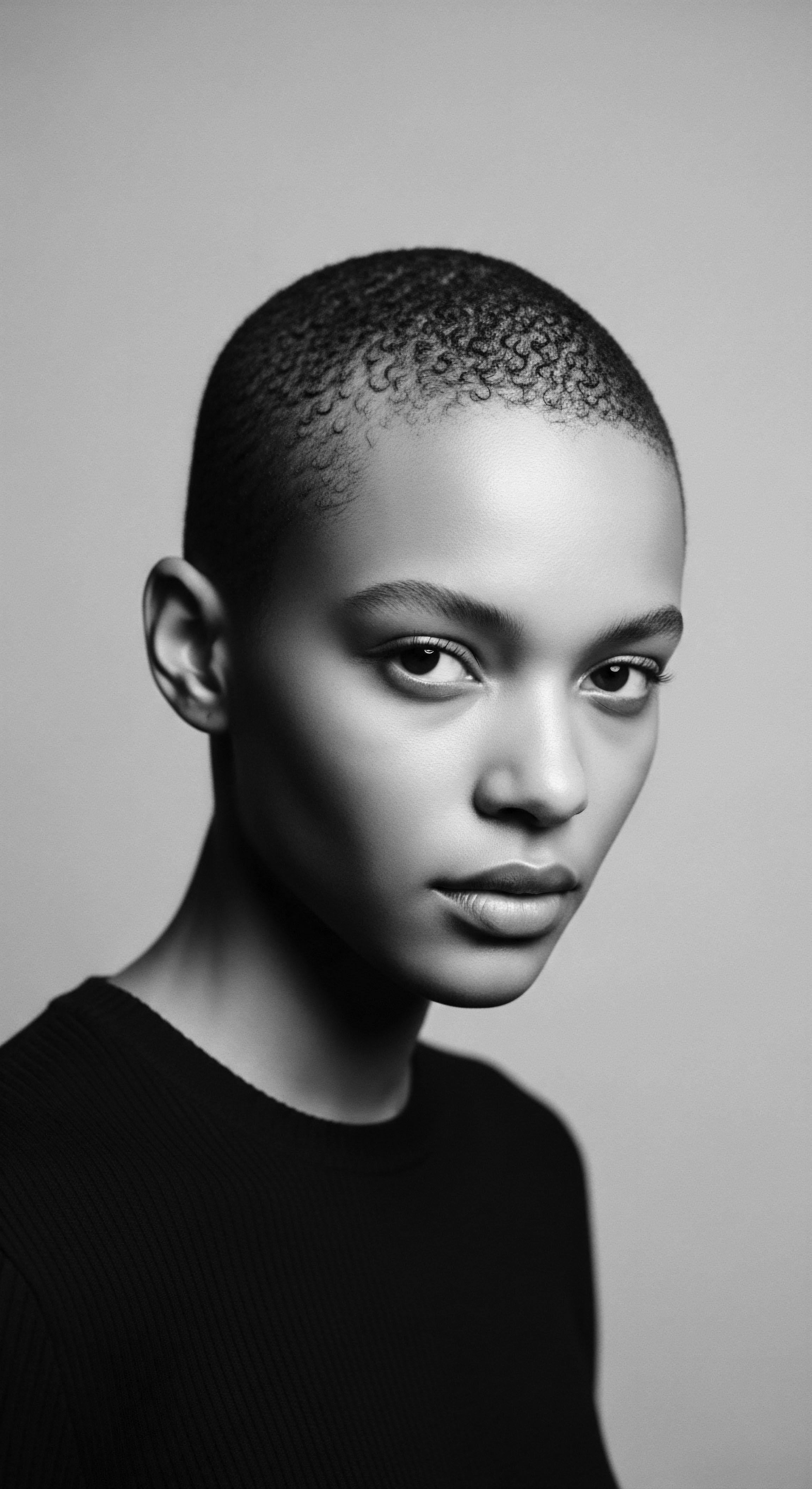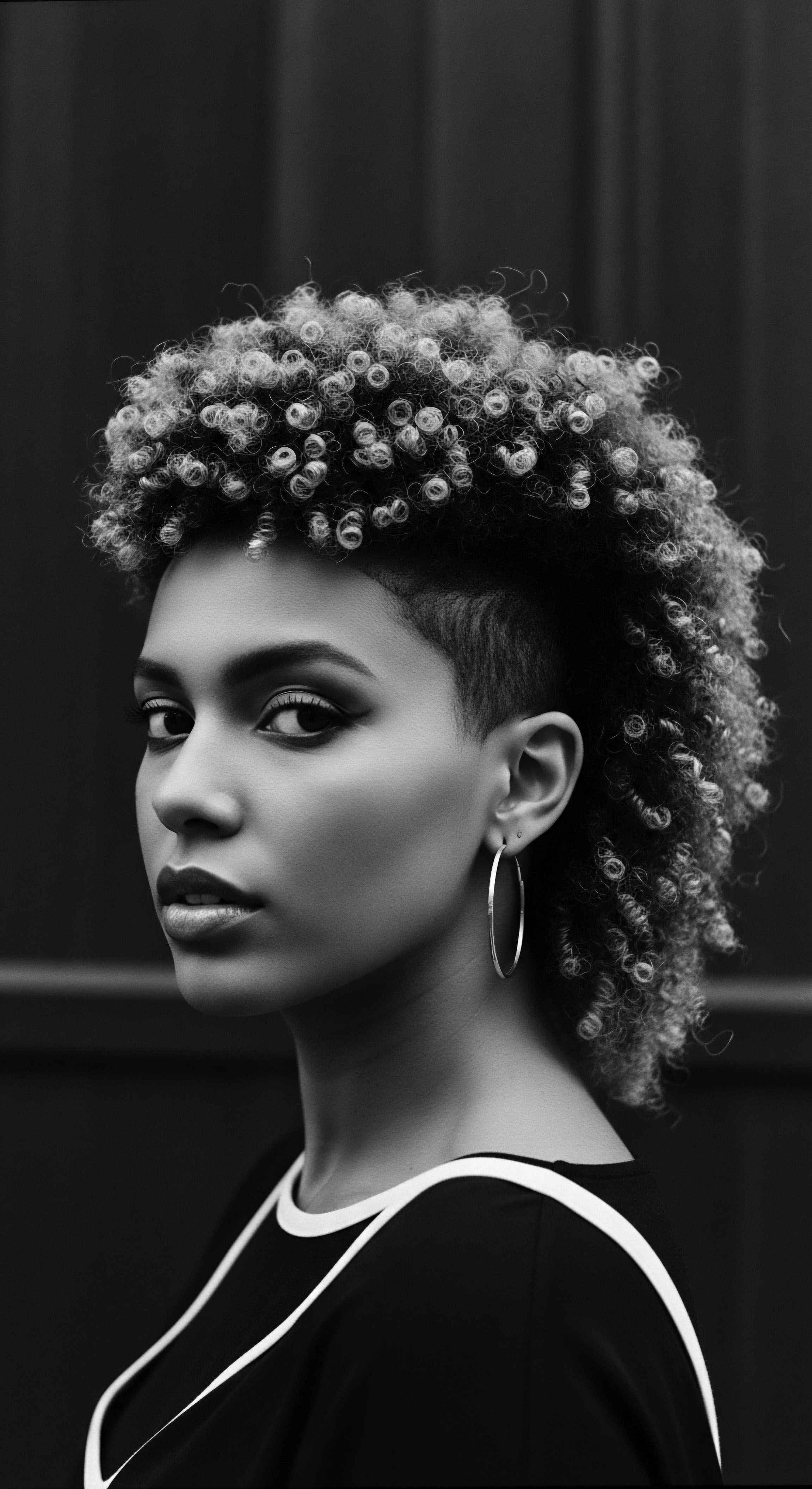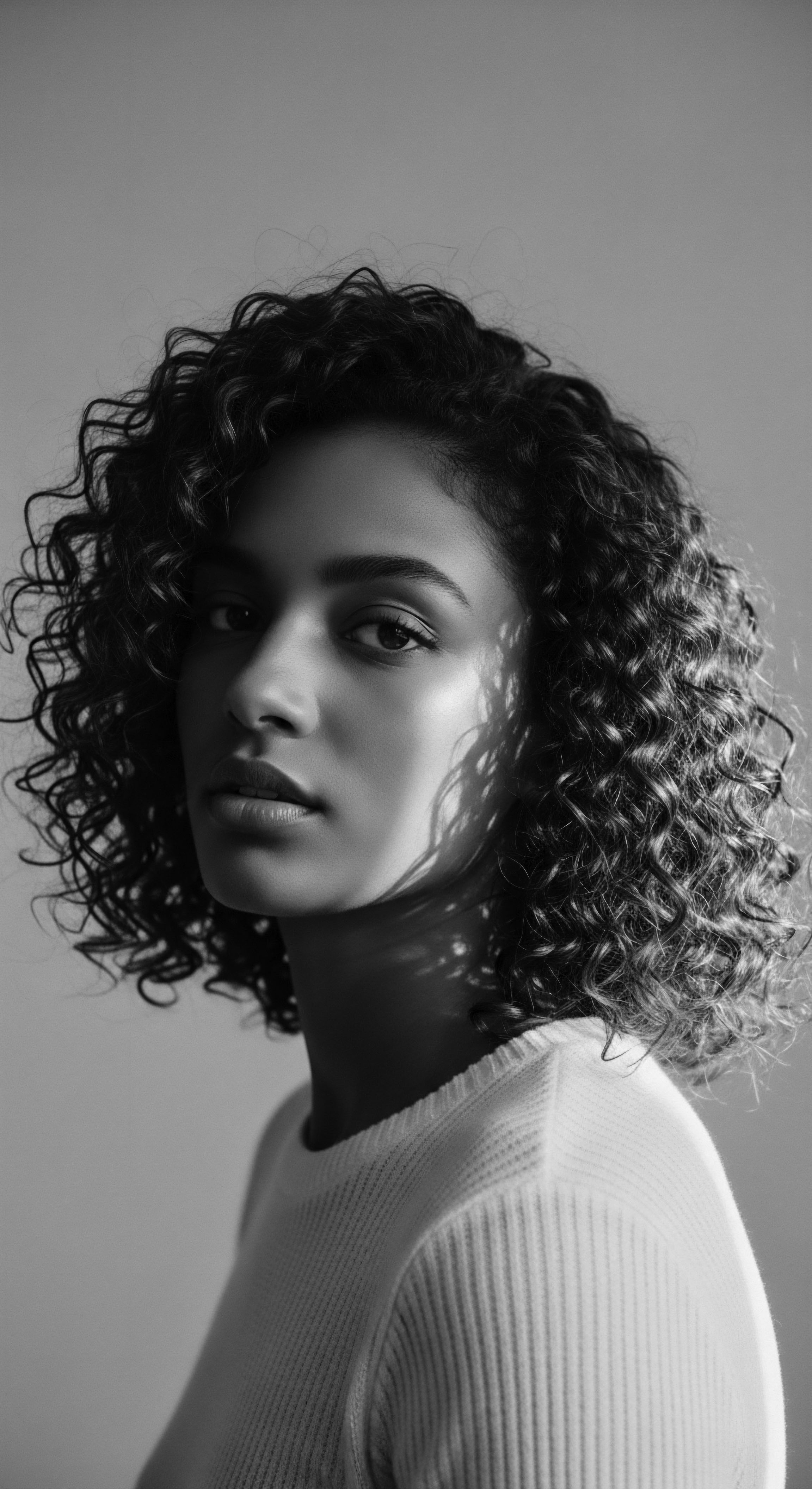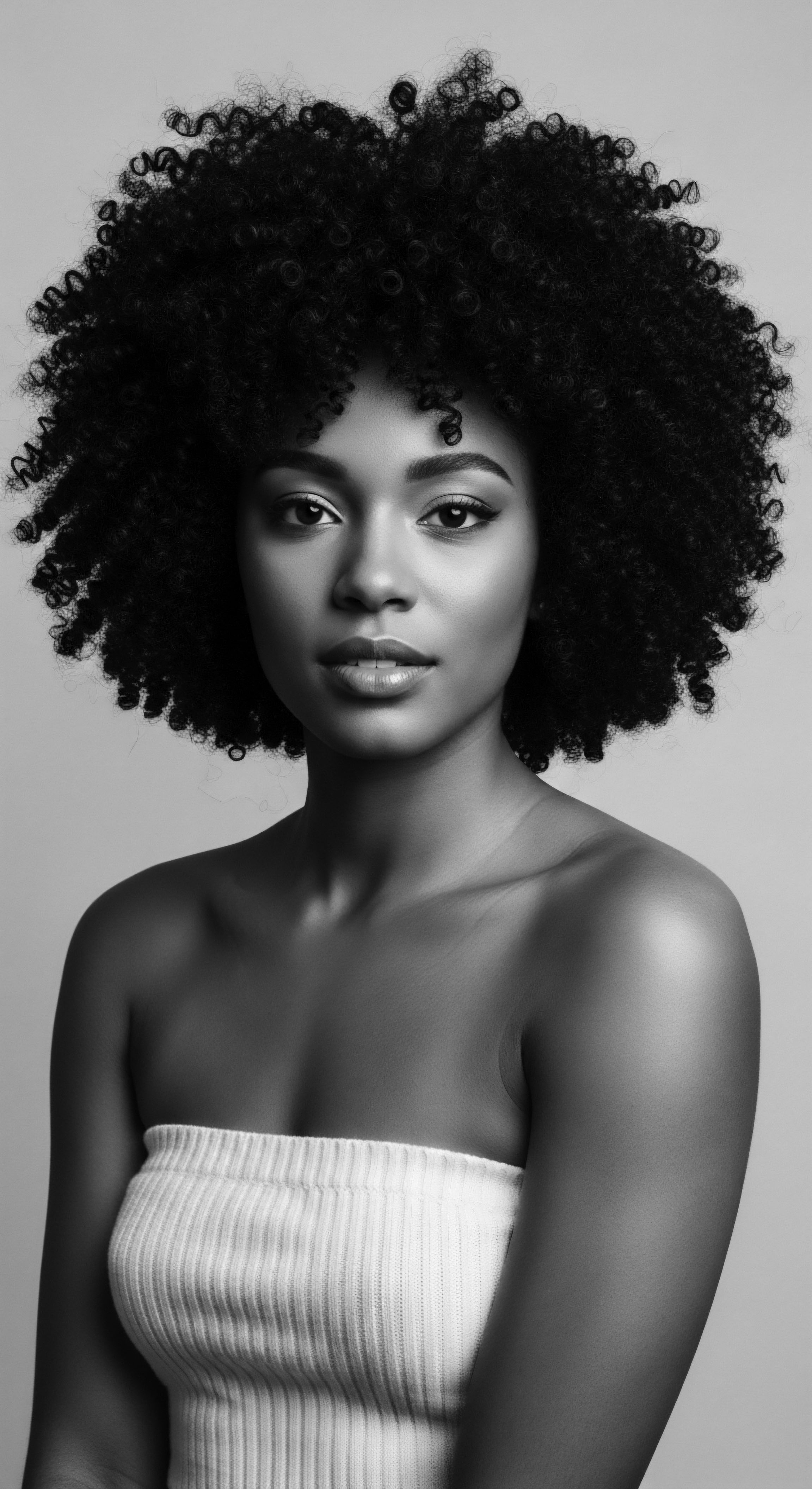
Roots
Consider for a moment the very strands that spring from the scalp, each a testament to a lineage stretching back through time, echoing across continents. For those with textured hair, this connection is more than poetic; it forms an unbroken line to profound ancestral truths. How perceptions of these varied helices have shifted across human history is a chronicle of power, identity, and deep cultural expression, a story etched into the very fibers of our being.
In the dawn of human existence, the earth itself was a guide, its rhythms dictating life. Our ancestors, acutely attuned to their surroundings, saw in textured hair a living crown, a shield, a visual language. This was a time when understanding the body flowed from intimate observation and a spiritual connection to the natural world.
Textured hair, with its unique structural geometry, was not merely an aesthetic feature; it signified strength, communal ties, and protection from the elements. The innate curl patterns, whether tightly coiled or softly waving, offered natural insulation against harsh sun and cold, while holding moisture close to the scalp, a biological marvel for survival in diverse climates.
Early human societies across Africa, particularly, held hair in reverence. It served as a conduit for spiritual connection, a symbol of societal standing, and a marker of identity. The earliest depictions of braided styles, dating back to 3000 BC in Stone Age paintings from the Tassili Plateu of the Sahara, bear witness to this ancient respect. These visual records, preceding many written histories, show textured hair styled with meticulous care, indicating its social weight.
The very act of styling became a communal ritual, an intimate exchange of knowledge and stories, strengthening bonds between generations. These were not simply coifs; they were living archives.
Hair anatomy, when viewed through this ancestral lens, takes on a richer meaning. The elliptical cross-section of a textured hair strand, its unique twist, and the distribution of disulphide bonds within its cortex dictate its characteristic curl. This complex architecture, often referred to as kinky, coily, or curly, was celebrated. Ancient communities understood, through observation and practice, how to work with this inherent structure.
They used plant-based oils, butters, and clays, drawing upon an indigenous pharmacopeia to nourish and maintain the hair’s vitality. This wisdom, passed down through oral tradition and hands-on teaching, predates modern scientific classification systems, yet it aligns with a deep, intuitive grasp of hair biology.
The lexicon used to describe textured hair in these ancient times was embedded within a worldview that honored its natural state. Terms were not about deficiency or deviation but about distinctiveness and cultural relevance. Hair was identified by its form, its role in community rites, or its connection to lineage, far from the later, imposed categorizations that would seek to diminish its natural beauty. This foundational period, therefore, saw textured hair perceptions shaped by deep respect, functionality, and a profound sense of belonging within a communal tapestry.
Ancient perceptions of textured hair arose from a deep reverence for its functional, social, and spiritual significance within communities.

Early Adornment and Symbolic Systems
Across various ancient African civilizations, hair served as a nuanced communication system. In ancient Egypt, for instance, both men and women wore cornrows or simple braids, often embellished with gold thread and other precious adornments. The specific style could indicate social rank, marital status, age, or even religious beliefs. Warriors and kings, too, were identified by their elaborate braided hair, underscoring its role in conveying authority and status.
This societal understanding extended beyond mere aesthetics; hair was intrinsically tied to a person’s identity and their place within the community. The careful attention to hair, which included scented oils and lotus flowers, reflects a period where its care was considered a sacred practice, contributing to overall well-being.
- Shea Butter ❉ Used across West Africa for centuries to moisturize scalp and hair.
- Baobab Oil ❉ Extracted from the baobab tree, prized for its conditioning and strengthening properties.
- Black Soap ❉ A traditional cleanser, often made with plantain skins and palm oil, used for gentle cleansing.

How Did Ancestral Practices Inform Care?
Ancestral practices for textured hair care were not haphazard; they were informed by generations of observation and an intimate knowledge of local botanicals. The efficacy of traditional ingredients, often dismissed by later imposed beauty standards, is now frequently affirmed by modern scientific inquiry. For instance, the use of certain plant extracts for their moisturizing or strengthening properties echoes current understanding of emollients and proteins.
These practices were integrated into daily life, forming a holistic approach to wellness where the health of the hair mirrored the health of the individual and the community. This period represents a high point of collective appreciation for textured hair in its innate form, before external forces began to warp its standing.

Ritual
The story of textured hair, so deeply rooted in ancient reverence, was dramatically altered by seismic shifts in human history, fundamentally reshaping its perception and the intimate rituals associated with its care. The advent of the transatlantic slave trade and the subsequent era of colonialism represents one of the most devastating ruptures in this heritage. Millions of Africans were forcibly removed from their homelands, and one of the first acts of dehumanization was often the shaving of their heads upon arrival in the “New World.” This act was not merely for sanitation; it served as a brutal symbolic shearing of cultural identity, tribal ties, and the profound significance held within traditional hairstyles.
The systematic denigration of Afro-textured hair became a perverse tool of oppression. European colonists, viewing themselves as civilizing forces, classified Afro-textured hair as closer to animal fur or wool than human hair. This dehumanizing comparison served to justify enslavement and exploitation, embedding a narrative of inferiority into the very perception of textured hair. This period saw the imposition of Eurocentric beauty standards, which championed straight or loosely curled hair, rendering natural textured hair as “unprofessional,” “unattractive,” or “untidy.” The pressure to conform to these alien ideals became intertwined with the struggle for survival and social acceptance.
Yet, amidst this profound trauma, the spirit of textured hair heritage persisted, often through acts of quiet, powerful defiance. Enslaved individuals, despite immense hardship, found ways to maintain hair traditions. While public display of elaborate styles was often suppressed, the artistry of cornrows, for example, took on a new, clandestine significance. They became pathways of communication, maps to freedom.
Specific braid patterns could encode escape routes or signal meeting times along the Underground Railroad. Small tools or seeds were hidden within the tightly woven strands, providing sustenance or aid during escapes. This transformation of a beauty ritual into a survival strategy speaks volumes about the enduring ingenuity and resilience embedded within textured hair heritage.
The transatlantic slave trade weaponized textured hair perceptions, yet resilience manifested through hidden styling rituals and ancestral knowledge.

How Did Oppression Influence Care Practices?
With limited access to traditional tools or cleansing agents, enslaved people adapted, using what was available. They resorted to greases, kerosene, or even bacon fat to lubricate their hair, and utilized combs meant for livestock. This adaptation, born of dire necessity, highlights the lengths to which individuals went to care for their hair, even when stripped of their cultural resources.
This era also gave rise to the concept of “good hair,” which equated looser curls or straighter textures with proximity to European ideals and, consequently, better treatment or opportunities. This internal division, known as “texturism,” created a caste system within enslaved communities, further fracturing a once-unified appreciation for diverse hair forms.
| Period Pre-Colonial Africa |
| Dominant Perception of Textured Hair Symbol of identity, status, spirituality, community bond. |
| Associated Practice/Symbolism Intricate braids, natural oils, communal styling sessions. |
| Period Transatlantic Slave Trade/Colonialism |
| Dominant Perception of Textured Hair Dehumanized, primitive, "unruly"; associated with inferiority. |
| Associated Practice/Symbolism Head shaving, forced concealment, "good hair" hierarchy, cornrows as maps. |
| Period Post-Emancipation/Early 20th Century |
| Dominant Perception of Textured Hair Pressure to conform to Eurocentric standards for social mobility. |
| Associated Practice/Symbolism Hair straightening (hot combs, relaxers), Madam C.J. Walker's empire built on these products. |
| Period These periods illustrate a profound shift from reverence to suppression, with enduring acts of cultural preservation. |

Legislated Control and the Tignon Laws
The desire to control textured hair, and by extension the identity of Black individuals, extended beyond the plantation. A poignant example arose in 18th-century Louisiana with the enactment of the Tignon Laws in 1786. These laws specifically targeted free Black women of color in New Orleans who, despite their status, were renowned for their elaborate hairstyles that openly displayed their beautiful coils and kinks.
Their hairstyles drew significant attention, prompting concern among those who sought to maintain strict racial and social hierarchies. The Tignon Laws mandated that these women conceal their hair with a tignon, a scarf or handkerchief, thereby forcing a visible marker of their supposed lower social standing, regardless of whether they were free or enslaved.
This legislation, a direct assault on personal expression and cultural identity, aimed to diminish the perceived threat of their beauty and assert racial subordination. Yet, even in this oppressive context, the spirit of defiance found its outlet. Many Black women responded to the Tignon Laws not by simply complying, but by transforming the mandated headwraps into ornate and artistic expressions, using expensive fabrics and intricate folding techniques. This act, turning an instrument of oppression into a statement of style and dignity, represents a powerful example of cultural resistance and adaptation.
It underscored that while laws could dictate appearance, they could not fully extinguish the inherent pride and creativity tied to textured hair heritage. The Tignon Laws, though eventually fading in enforcement, left an indelible mark, highlighting how deeply intertwined hair perception was with social control and racial hierarchy during this challenging era.

Relay
The journey of textured hair perception continued its winding path, moving from periods of suppression to powerful moments of reclamation, acting as a historical relay of cultural assertion. The mid-20th century, particularly with the fervor of the Civil Rights Movement and the subsequent Black Power era, marked a profound turning point. Here, textured hair became more than a personal preference; it emerged as a potent political statement, a visible declaration of racial pride and collective identity. The mantra “Black is beautiful,” central to the Black Power movement, directly challenged centuries of Eurocentric beauty standards that had systematically denigrated Afro-textured hair.
The popularization of the Afro hairstyle during the 1960s and 1970s was a direct manifestation of this counter-hegemonic stance. It was an intentional rejection of chemical relaxers and hot combs—tools that had, for generations, been employed to straighten textured hair in a bid for social acceptance. Wearing one’s natural hair, previously deemed “unprofessional” or “unkempt,” became an act of self-affirmation and solidarity within diasporic communities. This shift was not merely cosmetic; it symbolized a deeper psychological liberation, a conscious embrace of one’s ancestral lineage and an assertion of self-worth against oppressive norms.
The Civil Rights era ignited a powerful re-affirmation of textured hair as a symbol of racial pride and political identity.

How Did Social Movements Shape Hair Expression?
The influence of figures like Angela Davis, whose iconic Afro became a symbol of militant activism, propelled the natural hair aesthetic into the mainstream consciousness, compelling even White America to recognize its political weight. This period also saw the rise of Rastafarianism, which, while originating earlier, gained wider visibility. Rastafarians wear their hair in dreadlocks for spiritual and Biblical reasons, and reggae music’s global reach introduced locs to broader audiences, further diversifying the landscape of celebrated textured styles.
Despite this powerful cultural shift, discrimination persisted. Even after the initial embrace of the Afro, the societal pressure to conform to Eurocentric ideals remained strong, particularly in professional settings. Legal challenges began to surface. In the 1976 case of Jenkins v.
Blue Cross Mutual Hospital Insurance, the U.S. Court of Appeals for the Seventh Circuit upheld a race discrimination lawsuit, affirming that workers had the right to wear Afros under Title VII of the Civil Rights Act. However, the legal battles continued, with cases challenging braids and other culturally specific styles, illustrating the long, arduous path toward full acceptance.
- Afrocentric Styles ❉ Reclaiming natural coils and kinks as statements of heritage.
- Braids and Locs ❉ Honoring ancient African traditions and spiritual connections.
- Protective Styles ❉ Continuing a legacy of hair care that minimizes manipulation and promotes health.

The Contemporary Resonance and Legal Battles
The “natural hair movement” of recent decades represents a continuation of this relay, building upon the foundations laid by earlier generations. This contemporary resurgence is fueled by increased access to information, a greater understanding of textured hair science, and a desire to honor one’s authentic self. Yet, even today, race-based hair discrimination remains a persistent challenge.
A study by Dove in the UK revealed that half of Black and mixed women with Afro-textured hair have faced discrimination because of their hair. This enduring bias often manifests in professional or educational settings, where textured styles are still perceived as “unprofessional” or “untidy,” echoing the dehumanizing language of the past.
In response, legislative efforts like the CROWN Act (Creating a Respectful and Open World for Natural Hair) have emerged in various U.S. states. These laws prohibit discrimination based on hair texture or protective hairstyles historically associated with race. For instance, the New York City Commission on Human Rights declared in early 2019 its commitment to protecting residents’ legal right to wear locs, Afros, and braids, asserting that natural hair is inextricably tied to race and thus protected under civil rights law.
This legislative push signifies a collective societal recognition that textured hair is not merely a style; it embodies identity, culture, and a deeply rooted heritage that demands respect and protection. The ongoing struggle and legislative victories serve as powerful evidence that the perception of textured hair remains a central arena for battles over racial equality and self-determination.

Cultural Validation and Scientific Understanding
The modern era also brings a deeper scientific understanding that validates ancestral care practices. Research into the specific protein structures, lipid composition, and moisture dynamics of textured hair has provided a scientific basis for the efficacy of traditional plant-based oils and butters. This convergence of scientific discovery with ancestral wisdom has reinforced the value of inherited practices.
It speaks to a fuller appreciation of textured hair, moving beyond superficial judgments to an understanding grounded in both its unique biology and its profound cultural significance. This period allows for a comprehensive appreciation, where the echoes of ancient reverence meet the clarity of modern scientific insight, strengthening the appreciation for this unique hair heritage.

Reflection
The journey through time reveals that textured hair has always been more than keratin and pigment; it is a living archive, each curl and coil holding stories of resilience, beauty, and enduring cultural spirit. From the ancient African reverence that saw hair as a sacred conduit, through the systematic denigration of the transatlantic slave trade and colonialism, to the powerful reclamations of identity in modern movements, the perceptions of textured hair have undergone dramatic transformations. Yet, through every shift, the deep connection to heritage has remained, often hidden, sometimes suppressed, but never truly severed.
The story of textured hair is one of constant adaptation, resistance, and self-definition. It reminds us that external judgments, born of ignorance or malice, cannot diminish the inherent value and history of a people’s crowns. Every choice to wear textured hair in its natural state, to honor traditional styles, or to simply tend to it with care, acts as a whisper from the past, a vibrant shout in the present, and a guiding light for the future. It calls upon us to recognize the profound legacy woven into each strand, understanding that caring for textured hair is an act of honoring ancestry, affirming self, and participating in a continuous lineage of strength and grace.

References
- Byrd, Ayana D. and Lori L. Tharps. Hair Story ❉ Untangling the Roots of Black Hair in America. St. Martin’s Press, 2001.
- Garrin, C. & Marcketti, S. Black Hair in the United States ❉ A Historical and Cultural Perspective. Palgrave Macmillan, 2018.
- Goffman, Erving. The Presentation of Self in Everyday Life. Anchor Books, 1959.
- Peters, Elizabeth. African Hair Braiding ❉ A Guide to the Ancient Art of Hair Braiding. Chicago Review Press, 1990.
- Seidman, I. Interviewing as Qualitative Research ❉ A Guide for Researchers in Education and the Social Sciences. Teachers College Press, 2013.
- Walker, Alice. In Search of Our Mothers’ Gardens ❉ Womanist Prose. Harcourt Brace Jovanovich, 2007.
- White, Shane, and Graham White. Stylin’ ❉ African American Expressive Culture from Its Beginnings to the Zoot Suit. Cornell University Press, 1998.
- Wilson, Charles Reagan. The New Encyclopedia of Southern Culture ❉ Volume 26 ❉ Race and Ethnicity. University of North Carolina Press, 2013.
